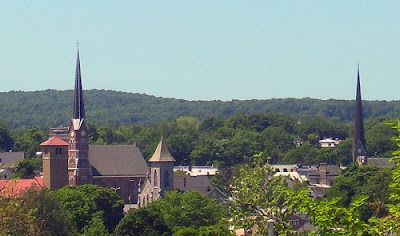Located in southeastern New York State, Orange County is directly
north of the border with New Jersey, west of the Hudson River, east of the
Delaware and northwest of New York City. Points
of interest in Orange County include the US Military Academy at West Point,
America’s oldest winery in Washingtonville, the Harness Racing Museum and Hall
of Fame in Goshen, the first cold press daily in the nation in Middletown.
Transportation the region is served by Stewart International, located
west Newburgh, and providing national and international flights. Ground transportation consists of bus service within Orange County and
rail to New York City.
History Orange County was established in1683, when the Province of New York was
divided into twelve counties. At that time, the only inhabitants of the
area were the native Munsee people, with the first European settlers arriving
in 1685 consisting of twenty-five families from Scotland. In 1709, a group of
German Palatine refugees settled in Newburgh; the Dutch and English arrived
in 1712 and additional immigrants came from Ireland. In 1798, after the
American Revolutionary War, the boundaries of Orange County changed; the
southern end was ceded to the new Rockland County and an area north of Moodna
Creek was added.
Port Jervis is at the confluence of the Neversink and Delaware Rivers in the
western part of the county and north of the Delaware Water Gap. Port Jervis
industrial history includes a role in shipping coal to major markets to the
southeast by canal and later by railroads as well as long-distance rail passenger
service until 1970. Today, tourists pass through Port Jervis on their way to
enjoying rafting, kayaking, canoeing and other activities in the Delaware Water
Gap National Recreation Area and the Upper Delaware Scenic and Recreational
Region.
Port Jervis is named for Delaware and Hudson Canal Chief Engineer John
Bloomfield Jervis
Middletown is situated between Port Jervis and Newburgh. Incorporated as a
city in 1888. It grew in the 19th and early 20th centuries
as a stop on several lower New York State railroads, attracting small
manufacturing businesses. The surrounding area is partly devoted to small dairy
farms. The downtown area is home to an active bar and restaurant scene,
historic churches, and prosperous neighborhoods like Presidential Heights.
Highland Avenue is lined with large Victorian houses, some of the largest of
which are now used as nursing homes.
Newburgh is situated on land that rises
sharply to a bluff; many historic homes are located here with sweeping views of
the Hudson river and highlands to the south. Newburgh's
preservation history can be traced to 1850 when Washington's Headquarters was
designated a state historic site, the first in the country. The Historical
Society of Newburgh Bay and the Highlands was chartered by the State of New
York in 1884. The David Crawford House on Montgomery Street, built in 1834, is
the current home of the Newburgh Historical Society. The city's modern preservation efforts led to the development of a
historic district the second largest in New York State. The city's historic
architecture features historic designs by Andrew Jackson Downing, Frederick Law
Olmsted and Calvert Vaux.
Newburgh was designated a Preserve America community in 2005
Destinations Itineraries and Travel Services with
Knowledge Tourism
in Newburgh Port Jervis and Middletown New York




